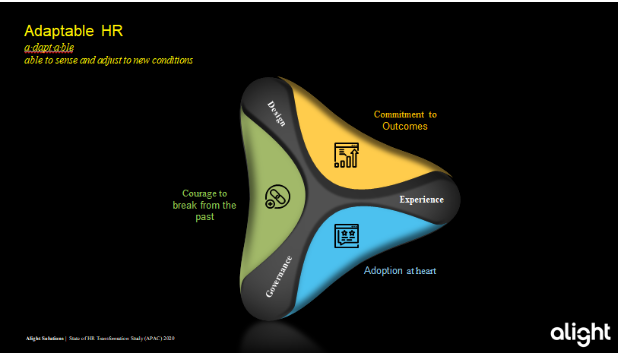Key to a successful HR Technology Deployment

From the greater collaboration between HR and business to improved employee experience to data-driven decisions powered by analytics-these are some of the visions and goals that almost every HR transformation project aims for. However, the HR transformation journey often ends with limited gains - a system deployment that rehashes existing processes and policies on a slightly shinier digital platform. The questions at large are: How does technology deployment constantly stay true to delivering business objectives? How do we maximize the gains of new technology and align and integrate processes, policies, and technology so that they work in tandem?
In order to address these questions, Vikrant Khanna, Partner, and Asia Lead, Advisory, Alight Solutions conducted a virtual masterclass to define what makes a successful HR technology deployment whilst exploring the journey that organizations have taken in order to balance deployment effectiveness, business priorities, and employee experience. Vikrant had crafted his presentation based on the insights from Alight Solutions State of HR Transformation Study 2020. It is the biggest HR Transformation study conducted in the Asia-Pacific region and recorded responses of over 1300 participants.
Here are some key insights from the session-
Change is changing faster than ever: Vikrant started the session by sharing that the pace of acceleration of change has just increased multi-folds. The pace at which business break-throughs are happening, the nature of organizations and jobs are getting re-configured, talent aspirations and experience are undergoing a tremendous shift. The notion of speed, agility, and innovation are all coming together. It all points together to organizations needing to be more adaptable, they should be able to sense the change, respond to them and that too at a much faster pace than their competitors, non-traditional in their space who can disrupt them. This is the era of accelerating change.
Adaptable HR:
HR organizations will also need to be more and more adaptable. Vikrant used a representation of a fidget, triangle to depict the adaptability of HR. He shared that a triangle is a shape which talks about continuous motion and fluidity. The colored spaces in the triangle are the key anchors that define the adaptability of HR organizations and they are committed to outcomes at an organization and talent levels. The adaptable HR organizations will have the courage to break away from the past, more akin to experimentation, challenging business-backed on data.
The three essential elements of adaptability are: adoption, outcomes and breaking away from the past and they are all held together in our ways of working. The way we design programs, deliver and measure experience, and how we challenge ourselves to continuously improve upon it through governance.
Adaptability is built on the foundation of the HR Operating Model and complimenting HR Technology. And in between technology and operating models, technology accelerates things further and the result proves this.

Four Stages in HR technology deployment:
- Planning: Vikrant shared that planning is the most critical element of the HR technology deployment as most of the deployments that have gone wrong were at the planning stage. The clarity on why a technology is being deployed, what are the goals, how will they be measured is essential. And once all of this is in place, executive buying will be exemplary.
Another important layer is to coin it as a transformation only when it really is. The transformation has to be pervasive in nature and should be an organization-wide experience. 2020 is the year deemed for unification. It helps in collating data in one place, more experimentative-ness with niche technologies, newer technologies for analytics to create incremental benefits for the core HR functions. - Evaluation: Vikrant stressed that evaluation should be done for an overall experience and not just technical specifications. One should not just limit their search with just platforms but should also consider the organizations that have designed them. Because eventually, one will evaluate platforms for innovation, commitment for the domain and all of this cannot be assessed with technical requisites. It is ultimately a relationship between two organizations and the platform is merely a currency in between. Evaluation should also be futuristic in nature, as in do not go for a technology which is great today but also envisage how it will be two years down the line. Technology deployment should be factored on the overall cost of ownership, not just the subscription cost.
- Deployment: Analytical capabilities, user experience, the total cost of ownership, deployment partner, all of these have grown tremendously in its trajectory.
In addition to this, Vikrant also shared the importance of time spent by senior HR leaders and how it is imperative in successful HR Technology deployments. The requirements, configuration, testing the technology and then deployment come in. Adoption, system integration and then going live should be planned. - Realization: Vikrant reiterated the importance of the vision and how the deployment will only be as good as the vision. So the vision is primary and then collaboration with the multiple teams who would be working together on the technology. The generation of the right insights with collaboration across teams is important for a successful journey.
And in the end, Vikrant beautifully concluded by saying that going live should never be the only motive but having a journey mindset is. All four steps are in-sync with each other and should be carefully planned and executed. He aptly concluded that the organizations should practice arrogance in their ambitions and humility in the execution. This is truly the key to successful HR Technology deployments.
You can watch the session here:
















